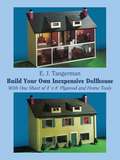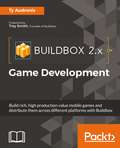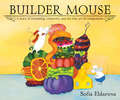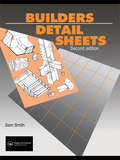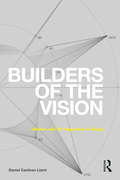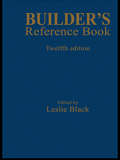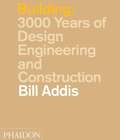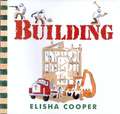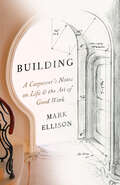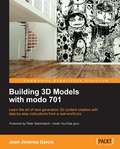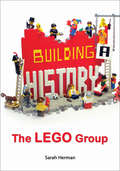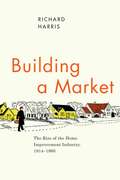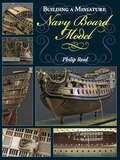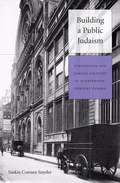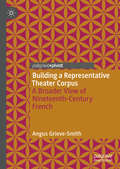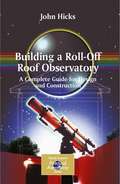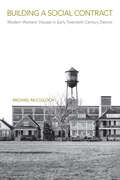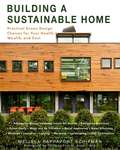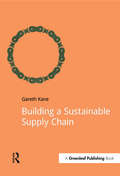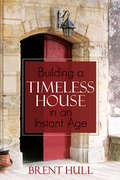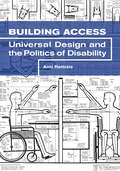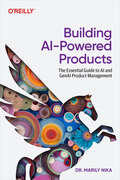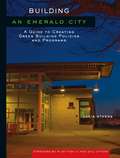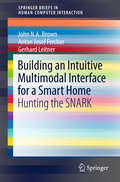- Table View
- List View
Build Your Own Inexpensive Dollhouse
by E. J. TangermanAnyone, even a novice woodworker or a child with adult supervision, can build this spacious dollhouse. All it takes is six basic tools (a folding rule, square, saber saw, rasp, sander, and hammer) and a single sheet of 4' x 8' plywood. The finished two-story model measures 36 1/2" x 26" (scale 1" x 1') and boasts six rooms, plus a staircase, windows, shutters, and a front door.The easy-to-follow instructions offer advice on purchasing the appropriate kind of plywood and trimmings and explain exactly how to cut and assemble the pieces. Helpful tips include suggestions on sanding, which pieces to nail first, constructing the roof, and finishing the project with paint or siding.The basic house design is simple, so builders have ample room to refine the house to suit their own preferences. Dozens of diagrams and instructions show how to add optical touches such as dormers, windowpanes, a fireplace, flower boxes, and much more. All instructions are clarified by illustrations -- over 40 diagrams and photographs appear throughout the book, showing the dollhouse in various stages of completion.
Buildbox 2.x Game Development
by Ty AudronisBuild rich, high production value mobile games and distribute them across different platforms with Buildbox About This Book * Create captivating 2D & 2.5D (isometric) video games for all platforms * Leverage Buildbox to monetize and prepare your games for distribution * This step-by-step tutorial will get you generating complex and media rich games with no coding experience Who This Book Is For This book caters to those who have an interest or desire to create their own mobile games either as a hobbyist or who are looking to enhance their skills as a professional games developer. No coding experience is required. What You Will Learn * Create the illusion of a 3D background in your game using parallax * Add advanced controls and obstacles to our first world * Develop assets (graphic and audio) for the Buildbox engine * Design games based on the capabilities and limitations of Buildbox and their target platforms * Compile and distribute video games on various channels such as Steam, iOS store, Android stores, and the Mac App Store * Optimize your games to get the absolute best quality within platform restrictions * Conquer common issues experienced with Buildbox development In Detail Buildbox is an "any skill level" development platform to develop video games with no coding experience. It also exports these games to be compiled for any platform (from Windows to Mac to iOS to Android and Blackberry) all using the same graphic user interface. Using an example as a tutorial, we will relate the driving principles and you'll see how you can implement these principles to develop any games on the platform. We begin by setting expectations and providing a brief overview of the software. But it's not long before you "dive in" to creating your first video game. You will actually have a playable level ("world") by the end of the second chapter. Later on, you'll learn everything from basic graphics creation to advanced world design while you refine your first game, called "Ramblin' Rover." All along the way, you will see how certain functions could be used in tandem to create other types of games; hoping to spark imagination. We will follow the principles and process of monetization through ads and in-game rewards. Lastly, we will go through the process of exporting, compiling, and preparing your storefront to sell the games you will eventually create. Style and approach This book follows a tutorial-based approach that teaches through examples, while also providing the necessary principles to enable you to abstract these principles into any game you want to make.
Builder Brothers: Big Plans (Ukrainian Edition)
by Drew Scott Jonathan ScottTranslated by Dasha Peipon, writer, editor and teacher, who’s originally from Ukraine, and Larysa Tsilyk, a Ukrainian poet, HarperCollins Children’s Books is happy to make available in ebook format this picture book in the Ukrainian language for no charge in the hopes that it will bring joy to displaced Ukrainian children and their families.Drew and Jonathan Scott, New York Times bestselling authors and hosts of the Emmy-nominated hit HGTV show Property Brothers, bring their winning blend of imagination, humor, and can-do know-how to their first picture book.It all begins when Drew and Jonathan are doing what they do best—thinking up big plans for even bigger projects. Will they build a treehouse? A castle? A catapult? They have a whole lot of big ideas, but no one thinks they can do any of them!The twins brainstorm, scribble, and tinker until they have the perfect big plan. They’ll save every last penny, sketch out some designs, and make a whole lot of noise—builders aren’t known for being quiet—because they know that little kids can do big things.But what will Drew and Jonathan do when their big plans don’t go the way they’d hoped? Find out in this heartwarming new story from everyone’s favorite twins.And the book comes complete with an original do-it-yourself building project that parents and kids can tackle together at home. Everyone knows that every big plan starts with a dream!
Builder Mouse
by Sofia EldarovaTwo mouse friends have two distinctly different uses for leftovers. Edgar loves to build with them. Toby loves to eat them. This makes life challenging. So Edgar sets out to find someone who will appreciate his creations as art, and not as lunch. This sly, appealingly understated, and warm-hearted book is the American debut of the author/illustrator Sofia Eldarova.
Builders' Detail Sheets (Series 1)
by S. Smith Mr P Stronach P. StronachThis book contains a unique set of information sheets, covering all aspects of building from sit setting-out to roofs and floors. It gives builders and students of building a sound knowledge of materials, their properties and limitations, and shows the practice of using these materials for sound construction. The sheets also give information on the Building Regulations and how to comply with them.
Builders of the Vision: Software and the Imagination of Design
by Daniel Cardoso LlachBuilders of the Vision traces the intellectual history and contemporary practices of Computer-Aided Design (CAD) and Numerical Control since the years following World War II until today. Drawing from primary archival and ethnographic sources, it identifies and documents the crucial ideas shaping digital design technologies since the first numerical control and CAD systems were developed under US Air Force research contracts at MIT between 1949 and 1970: the cybernetic theorization of design as a human-machine endeavor; the vision of computers as "perfect slaves" taking care of the drudgery of physical labor; the techno-social utopias of computers as vehicles of democracy and social change; the entrepreneurial urge towards design and construction integration; and the managerial ideologies enabling today’s transnational geographies of practice. Examining the contrasting, and often conflicting, sensibilities that converge into CAD and BIM discourses - globalism, utopianism, entrepreneurialism, and architects’ desires for aesthetic liberation - Builders of the Vision shows that software systems and numerically controlled machines are not merely "instruments," or "tools," but rather versatile metaphors reconfiguring conceptions of design, materiality, work, and what it means to be creative. Crucially, by revealing software systems as socio-technical infrastructures that mediate the production of our built environments, author Daniel Cardoso Llach builds a strong case for the fields of architecture, media, and science and technology studies to critically engage with both the politics and the poetics of technology in design. Builders of the Vision will be essential reading for scholars and practitioners across disciplines interested in the increasingly complex socio-technical systems that go into imagining and building of our artifacts, buildings, and cities.
Builder's Reference Book
by Leslie BlackA comphensive guide to information sources relevant to the building industry and legislation affecting it. It is designed for use as a tool either in the office or on site, giving facts in a compendium style to meet the most common requirements of the busy builder.
Building: 3,000 Years of Design, Engineering and Construction
by Bill AddisCambridge International AS and A Level Business Studies Revision Guide has been designed to help students prepare for Cambridge International AS and A Level Business Studies (9707) examinations. Written in an easy-to-follow style, the book helps in reinforcing students' understanding and provides guidance on revision.
Building
by Elisha CooperIt begins with an empty city lot and ends with a gleaming new building. But what happens in between? With his trademark sketch pad, watercolors, and sharp eye for atmosphere and detail, Elisha Cooper takes note of what goes on at a construction site -- from the obvious to the not-so-obvious. And curious young builders will relish his funny observations and unfailing scrutiny. There are backhoes that look like messy eaters, and lots of hammering that sounds like do-re-mi. Come see (and hear) the building -- it's going up now!
Building: A Carpenter's Notes on Life & the Art of Good Work
by Mark EllisonA visionary carpenter shares indelible stories on building a life worth living, revealing powerful lessons about work, creativity, and design through his experience constructing some of New York&’s most iconic spaces.For forty years, Mark Ellison has worked in the most beautiful homes you&’ve never seen, specializing in rarefied, lavish, and challenging projects for the most demanding of clients. He built a staircase that the architect Santiago Calatrava called a masterpiece. He constructed the sculpted core of Sky House, which Interior Design named &“Apartment of the Decade.&” His projects have included the homes of David Bowie, Robin Williams, and others whose names he cannot reveal. He is regarded by many as the best carpenter in New York.Building: A Carpenter&’s Notes on Life & the Art of Good Work tells the story of an unconventional education and how fulfillment can be found in doing something well for decades. Ellison takes us on a tour of the lofts, penthouses, and townhomes of New York&’s elite, before they&’re camera-ready. In a singular voice, he offers a window into learning to live meaningfully along the way. From staircases that would be deadly if built as designed and algae-eating snails boiled to escargot in a penthouse pond, to the deceptive complexity of minimalist design, Building exposes the tangled wiring, scrapped blueprints, and outlandish demands that characterize life in the high-stakes world of luxury construction.Blending Ellison&’s musings on work and creativity with immersive storytelling and original sketches, photos, and illustrations, Building is a meditation on crafting a life worth living, and a delightful philosophical inquiry beyond the facades that we all live behind.
Building 3D Models with modo 701
by Juan Jimenez GarciaThe book will focus on creating a sample application throughout the book, building gradually from chapter to chapter.If you are new to the 3D world, this is the key to getting started with a modern software in the modern visualization industry. Only minimal previous knowledge is needed.If you have some previous knowledge about 3D content creation, you will find useful tricks that will differentiate the learning experience from a typical user manual from this, a practical guide concerning the most common problems and situations and how to solve them.
Building a History: The Lego Group
by Sarah HermanThe story of these beloved bricks and the people who built an empire with them. From its inception in the early 1930s right up until today, the LEGO Group&’s history is as colorful as the toys it makes. Few other playthings share the LEGO brand&’s creative spirit, educational benefits, resilience, quality, and universal appeal. This history charts the birth of the LEGO Group from the workshop of a Danish carpenter and its steady growth as a small, family-run toy manufacturer to its current position as a market-leading, award-winning brand. The company&’s growing catalogue of products—including the earliest wooden toys, plastic bricks, play themes and other building systems such as DUPLO, Technic, and MINDSTORMS—are chronicled in detail, alongside the manufacturing process, LEGOLAND parks, licensed toys, and computer games. Learn all about how LEGO pulled itself out of an economic crisis and embraced technology to make building blocks relevant to twenty-first century children, and discover the vibrant fan community of kids and adults whose conventions, websites, and artwork keep the LEGO spirit alive. Building a History will have you reminiscing about old Classic Space sets, rummaging through the attic for forgotten minifigure friends, and playing with whatever LEGO bricks you can get your hands on (even if it means sharing with your kids).
Building a Market: The Rise of the Home Improvement Industry, 1914-1960
by Richard HarrisEach year, North Americans spend as much money fixing up their homes as they do buying new ones. This obsession with improving our dwellings has given rise to a multibillion-dollar industry that includes countless books, consumer magazines, a cable television network, and thousands of home improvement stores. Building a Market charts the rise of the home improvement industry in the United States and Canada from the end of World War I into the late 1950s. Drawing on the insights of business, social, and urban historians, and making use of a wide range of documentary sources, Richard Harris shows how the middle-class preference for home ownership first emerged in the 1920s--and how manufacturers, retailers, and the federal government combined to establish the massive home improvement market and a pervasive culture of Do-It-Yourself. Deeply insightful, Building a Market is the carefully crafted history of the emergence and evolution of a home improvement revolution that changed not just American culture but the American landscape as well.
Building a Miniature Navy Board Model
by Philip ReedThe expert model maker takes readers through every stage of building a miniature navy board model in this fully illustrated step-by-step guide. In this clear and detailed volume, Phil Reed tackles the ultimate expression of the ship model maker's art: The Navy Board model. These early eighteenth-century works of art are well represented in major maritime museums and private collections. Here, Reed takes on the construction of a miniature 1/192 scale model of the Royal George of 1715, covering all the conventions of Navy Board framing and planking. With nearly 400 photographs, each accompanied by explanatory text, Building a Miniature Navy Board Model takes readers through every step of the process. Methods of hull and deck framing, internal and external planking, and the construction of the complex stern are all covered. The rendering of the multitude of decorative carvings on the figurehead, stern and broadside is also demonstrated. At the end of the book there is a short section showing his model of The Syren, which demonstrates how the techniques used to frame Royal George could be adapted for ships of a later date, using single and double frames closer to full-size practice
Building a Public Judaism
by Saskia Coenen SnyderNineteenth-century Europe saw an unprecedented rise in the number of synagogues. Building a Public Judaism considers what their architecture and the circumstances surrounding their construction reveal about the social progress of modern European Jews. Looking at synagogues in four important centers of Jewish lifeâLondon, Amsterdam, Paris, and BerlinâSaskia Coenen Snyder argues that the process of claiming a Jewish space in European cities was a marker of acculturation but not of full acceptance. Whether modest or spectacular, these new edifices most often revealed the limits of European Jewish integration. Debates over building initiatives provide Coenen Snyder with a vehicle for gauging how Jews approached questions of self-representation in predominantly Christian societies and how public manifestations of their identity were received. Synagogues fused the fundamentals of religion with the prevailing cultural codes in particular locales and served as aesthetic barometers for European Jewryâs degree of modernization. Coenen Snyder finds that the dialogues surrounding synagogue construction varied significantly according to city. While the larger story is one of increasing self-agency in the public life of European Jews, it also highlights this agencyâs limitations, precisely in those places where Jews were thought to be most acculturated, namely in France and Germany. Building a Public Judaism grants the peculiarities of place greater authority than they have been given in shaping the European Jewish experience. At the same time, its place-specific description of tensions over religious tolerance continues to echo in debates about the public presence of religious minorities in contemporary Europe.
Building a Representative Theater Corpus: A Broader View of Nineteenth-Century French
by Angus Grieve-SmithThe Digital Parisian Stage Project aims to compile a corpus of plays that are representative of performances in the theaters of Paris through history. This book surveys existing corpora that cover the nineteenth century, lays out the issue of corpus representativeness in detail, and, using a random sample of plays from this period, presents two case studies of language in use in the Napoleonic era. It presents a compelling argument for the compilation and use of representative corpora in linguistic study, and will be of interest to those working in the fields of corpus linguistics, digital humanities, and history of the theater.
Building a Roll-Off Roof Observatory: A Complete Guide for Design and Construction (The Patrick Moore Practical Astronomy Series)
by John Stephen HicksAlmost every amateur astronomer who has taken the pursuit to its second level aspires to a fixed, permanent housing for his telescope, permitting its rapid and comfortable use avoiding hours of setting-up time for each observing session. A roll-off roof observatory is the simplest and by far the most popular observatory design for today's practical astronomers. Building a Roll-off Roof Observatory is unique, covering all aspects of designing a roll-off roof observatory: planning the site, viewing requirements, conforming to by-laws, and orientation of the structure. The chapters outline step-by-step construction of a typical building. The author, both an amateur astronomer and professional landscape architect, is uniquely qualified to write this fully-detailed book. A professionally designed roll-off observatory could cost as much as $3000 just for the plans - which are provided free with Building a Roll-off Roof Observatory.
Building a Social Contract: Modern Workers' Houses in Early-Twentieth Century Detroit (Urban Life, Landscape and Policy)
by Michael McCullochThe dream of the modern worker’s house emerged in early twentieth-century America as wage earners gained access to new, larger, and better-equipped dwellings. Building a Social Contract is a cogent history of the houses those workers dreamed of and labored for. Michael McCulloch chronicles the efforts of employers, government agencies, and the building industry who, along with workers themselves, produced an unprecedented boom in housing construction that peaked in the mid-1920s. Through oral histories, letters, photographs, and period fiction, McCulloch traces wage earners’ agency in negotiating a new implicit social contract, one that rewarded hard work with upward mobility in modern houses. This promise reflected workers’ increased bargaining power but, at the same time, left them increasingly vulnerable to layoffs. Building a Social Contract focuses on Detroit, the quintessential city of the era, where migrant workers came and were Americanized, and real estate agents and the speculative housebuilding industry thrived. The Motor City epitomized the struggle of Black workers in this period, who sought better lives through industrial labor but struggled to translate their wages into housing security amid racist segregation and violence. When Depression-era unemployment created an eviction crisis, the social contract unraveled, and workers rose up—at the polls and in the streets—to create a labor movement that reshaped American capitalism for decades. Today, the lessons McCulloch provides from early twentieth-century Detroit are a necessary reminder that wages are not enough, and only working-class political power can secure affordable housing.
Building a Sustainable Home: Practical Green Design Choices for Your Health, Wealth, and Soul
by Schifman MelissaThe green building movement has produced hundreds of “how-to” books and websites that are filled with tips about green building and what homeowners should do to go green. While helpful and informative, when it comes to making actual purchasing and installation decisions, these books do not make it any easier for a homeowner to prioritize against a budget. The Sustainable Home serves this need, as it is written by a sustainability advisor and financial advisor who has personally directed the building and LEED certification of her own home. Here, she shares her knowledge and experience for others to use in their journey toward a greener way of living. Whether the reader is building a new home or doing a minor remodel, a homeowner needs a framework by which to guide their decisions. These decisions are based on values, and the author posits that there are really only three reasons to go green: For Our Health: By building more sustainably, we reduce our exposure to harmful chemicals and toxins. For Our Wealth: By building a more durable home and being more efficient with resources like water and electricity, we reduce our monthly utility bills and ongoing maintenance expenses. For Our Soul: Collectively doing the right thing for our planet does make a difference—and that is soul-nourishing. Learn the logistics of choosing windows, insulation, appliances, and lighting. Find out about FSC certified wood and about using reclaimed materials. Here is everything you need to make your home sustainable.
Building a Sustainable Supply Chain (Doshorts Ser.)
by Gareth KaneThe massive oil spill in the Gulf of Mexico in 2010 was not caused by BP, but by a contractor, yet BP got the blame. The toxic waste from the production of Apple products dumped in China in 2011 was not dumped by Apple, but by a supplier, yet Apple got the blame. The horsemeat found in beef burgers in 2013 was not added by Tesco, but by a supplier, yet Tesco got the blame. In all three cases, blame for the damage caused by suppliers floated up through the supply chain until it lodged with the big brand at the top. No longer can companies constrain their corporate responsibility within the factory fence, as that boundary is not recognized by outside observers. This situation is exacerbated by the fact that the majority of most organizations’ environmental footprint lies in their supply chain. This means that, to address the sustainability agenda in a meaningful way, they must tackle the impacts of their suppliers. Unfortunately this is a huge challenge as visibility and influence diminishes quickly as you start to work your way down through the layers of suppliers. This book gives a quick but comprehensive guide to the most effective techniques to help you proactively address environmental risks in the supply chain. It covers the following: the business case for a sustainable supply chain; supply chains and sustainability: the big picture; making supply chains sustainable: the fundamentals; basic techniques: the "hard yards" of green procurement; intermediate techniques: those requiring changes to operations and products/services; advanced techniques: changes to the business model and corporate philosophy.The book draws upon exclusive interviews with top sustainability practitioners along with the practical experiences of the author to provide real world examples at the cutting edge.
Building a Timeless House in an Instant Age
by Brent HullThe author of Traditional American Rooms examines the evolution of home construction, making a case against mass-produced homes.HISTORY®’s Lone Star Restoration star, Brent Hull is a master craftsman, and hands-on preservationist. Hull—a Foreword Reviews Book of the Year Finalist for architectural non-fiction—challenges us to consider the impact our decisions will have when building a house. What do our homes say about us? What stories are they telling? Are they declarations of integrity, beauty, and heritage? Or do they suggest we have lost our sense of value, craft, and harmony?Nationally recognized as an authority on historic design, architecturally correct moldings, and millwork, Hull is uniquely qualified to speak to the craft of building and art of design. In an age of “instant”‘ homes, how do we build something timeless that weaves a tale of character, values, history, and heart? The decisions we make for our homes are not inconsequential. What we build defines us. In fact, the contrast between the way we build today and how structures used to be built has become only more vivid. What happened to craft? What happened to the art of building? Our values and what we believe about life have changed as well. We have come to see houses as a tradable commodity. We live in a time that is obsessed with “what’s next?” We need to be careful of fooling ourselves into thinking that a bottom-line mentality is the best way to approach building a home. Now is the time to examine ourselves, our motives, and our hearts.Praise for Building a Timeless House in an Instant Age“Part call to action, part exploration of technique, the result is a persuasive and enjoyable reminder that our homes are reflections of ourselves . . . . A pleasing, educational look at traditional home construction.” —Kirkus Reviews
Building Access: Universal Design and the Politics of Disability
by Aimi Hamraie&“All too often,&” wrote disabled architect Ronald Mace, &“designers don&’t take the needs of disabled and elderly people into account.&” Building Access investigates twentieth-century strategies for designing the world with disability in mind. Commonly understood in terms of curb cuts, automatic doors, Braille signs, and flexible kitchens, Universal Design purported to create a built environment for everyone, not only the average citizen. But who counts as &“everyone,&” Aimi Hamraie asks, and how can designers know? Blending technoscience studies and design history with critical disability, race, and feminist theories, Building Access interrogates the historical, cultural, and theoretical contexts for these questions, offering a groundbreaking critical history of Universal Design. Hamraie reveals that the twentieth-century shift from &“design for the average&” to &“design for all&” took place through liberal political, economic, and scientific structures concerned with defining the disabled user and designing in its name. Tracing the co-evolution of accessible design for disabled veterans, a radical disability maker movement, disability rights law, and strategies for diversifying the architecture profession, Hamraie shows that Universal Design was not just an approach to creating new products or spaces, but also a sustained, understated activist movement challenging dominant understandings of disability in architecture, medicine, and society.Illustrated with a wealth of rare archival materials, Building Access brings together scientific, social, and political histories in what is not only the pioneering critical account of Universal Design but also a deep engagement with the politics of knowing, making, and belonging in twentieth-century United States.
Building AI-Powered Products: The Essential Guide to AI and GenAI Product Management
by Marily NikaDrawing from her experience at Google and Meta, Dr. Marily Nika delivers the definitive guide for product managers building AI and GenAI powered products. Packed with smart strategies, actionable tools, and real-world examples, this book breaks down the complex world of AI agents and generative AI products into a playbook for driving innovation to help product leaders bridge the gap between niche AI and GenAI technologies and user pain points. Whether you're already leading product teams or are an aspiring product manager, and regardless of your prior knowledge with AI, this guide will empower you to confidently navigate every stage of the AI product lifecycle. Confidently manage AI product development with tools, frameworks, strategic insights, and real-world examples from Google, Meta, OpenAI, and moreLead product orgs to solve real problems via agentic AI and GenAI capabilitiesGain AI Awareness and technical fluency to work with AI models, LLMs, and the algorithms that power them; get cross-functional alignment; make strategic trade-offs; and set OKRs
Building an Emerald City: A Guide to Creating Green Building Policies and Programs
by Lucia AthensIn 2000, Seattle, Washington, became the first U.S. city to officially adopt the U.S. Green Building Council's LEED (Leadership in Energy and Environmental Design) "Silver" standards for its own major construction projects. In the midst of a municipal building boom, it set new targets for building and remodeling to LEED guidelines. Its first LEED certified project, the Seattle Justice Center, was completed in 2002. The city is now home to one of the highest concentrations of LEED buildings in the world. Building an Emerald City is the story of how Seattle transformed itself into a leader in sustainable "green" building, written by one of the principal figures in that transformation. It is both a personal account--filled with the experiences and insights of an insider--and a guide for anyone who wants to bring about similar changes in any city. It includes "best practice" models from municipalities across the nation, supplemented by the contributions of "guest authors" who offer stories and tips from their own experiences in other cities. Intended as a "roadmap" for policy makers, public officials and representatives, large-scale builders and land developers, and green advocates of every stripe, Building an Emerald City is that rare book--one that is both inspirational and practical.
Building an Intuitive Multimodal Interface for a Smart Home: Hunting the SNARK (Human–Computer Interaction Series)
by Gerhard Leitner John N.A Brown Anton Josef FercherThis book describes an innovative approach to the interaction between humans and a smart environment; an attempt to get a smart home to understand intuitive, multi-modal, human-centred communication. State of the art smart homes, like other "smart" technology, tend to demand that the human user must adapt herself to the needs of the system. The hunt for a truly user-centred, truly intuitive system has long proven to be beyond the grasp of current technology. When humans speak with one another, we are multimodal. Our speech is supplemented with gestures, which serve as a parallel stream of information, reinforcing the meaning of our words. Drawing on well-established protocols in engineering and psychology, and with no small amount of inspiration from a particular nonsense poem, we have successfully concluded that hunt. This book describes the efforts, undertaken over several years, to design, implement, and test a model of interaction that allows untrained individuals to intuitively control a complex series of networked and embedded systems. The theoretical concepts are supported by a series of experimental studies, showing the advantages of the novel approach, and pointing towards future work that would facilitate the deployment of this concept in the real world.
